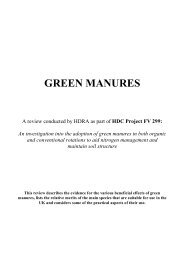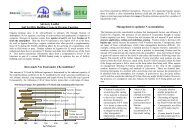A review of leguminous fertility-building crops, with particular ...
A review of leguminous fertility-building crops, with particular ...
A review of leguminous fertility-building crops, with particular ...
You also want an ePaper? Increase the reach of your titles
YUMPU automatically turns print PDFs into web optimized ePapers that Google loves.
A <strong>review</strong> <strong>of</strong> <strong>leguminous</strong> <strong>fertility</strong>-<strong>building</strong> <strong>crops</strong>, Defra project OF0316 2. Rotational aspects<br />
Table 2.3. Advantages and disadvantages <strong>of</strong> forage legumes (including green manures).<br />
Crop Advantages Disadvantages<br />
Red clover • Deep rooting<br />
• Vigorous growth<br />
• Large biomass for forage<br />
• High protein content forage<br />
White clover • Viable for 5-9 years<br />
• Good regeneration after drought<br />
Resistant to stem nematode<br />
• Suitable for undersowing/bicropping<br />
• Prostrate growth has good<br />
ground cover<br />
• Withstands heavy grazing<br />
Crimson clover • Resistant to clover rot<br />
• Tolerates acid soils better than<br />
red and white clover<br />
• Can disappear in grazed swards<br />
• Can cause bloat<br />
• Susceptible to stem nematode<br />
• Difficult to establish in autumn in<br />
north<br />
• Typical productive life <strong>of</strong> 3 years<br />
• Can be very competitive when<br />
undersown<br />
• Erect growth habit<br />
• Slow establishment, best established<br />
in spring<br />
• Lower biomass productivity<br />
• Forage can be stemmy<br />
• Erect growth habit<br />
• Does not like competition in a bicrop<br />
• Autumn establishment difficult<br />
• Does not like heavy soils<br />
• Rhyzome regenerates below ground<br />
Subterranean • Rhyzome regenerates below<br />
clover<br />
ground and survives cultivation and survives cultivation<br />
Alsike clover • Deep rooting<br />
• Tolerant <strong>of</strong> wet soils<br />
• Vigorous<br />
• Tolerant <strong>of</strong> acid soils<br />
• Large biomass for forage • Not drought resistant<br />
• High protein content forage<br />
Persian & • Vigorous growth<br />
• Not frost hardy<br />
Egyptian<br />
clover<br />
• Produce nutritious fodder <strong>crops</strong><br />
Lucerne/ • Deep rooting<br />
• Requires inoculum to establish<br />
alfalfa • drought tolerant<br />
• Slow to establish in year 1<br />
• fodder potential (including • Careful management to avoid over<br />
racehorses)<br />
winter loss/die back<br />
• Resistant to stem nematode • Has higher bloat risk as fresh forage<br />
• Can be undersown<br />
• Requires pH 6+<br />
• Productive for 5+ years<br />
Winter vetch, • Late sowing possible<br />
• May be difficult to kill in spring<br />
common vetch • Highly productive biomass • Viable seeds can become weeds in<br />
Summer vetch • Very competitive<br />
subsequent <strong>crops</strong><br />
• Useful cover for brassica cash<br />
<strong>crops</strong><br />
• High yielding as whole crop<br />
Written by S Cuttle, M Shepherd & G Goodlass Page 24




